-
PESQUISA01/01/2017
Virtual learning object and environment: a concept analysis
Revista Brasileira de Enfermagem. 2017;70(3):572-579
Resumen
PESQUISAVirtual learning object and environment: a concept analysis
Revista Brasileira de Enfermagem. 2017;70(3):572-579
DOI 10.1590/0034-7167-2016-0123
Visualizações0Ver maisABSTRACT
Objective:
To analyze the concept of virtual learning object and environment according to Rodgers’ evolutionary perspective.
Method:
Descriptive study with a mixed approach, based on the stages proposed by Rodgers in his concept analysis method. Data collection occurred in August 2015 with the search of dissertations and theses in the Bank of Theses of the Coordination for the Improvement of Higher Education Personnel. Quantitative data were analyzed based on simple descriptive statistics and the concepts through lexicographic analysis with support of the IRAMUTEQ software.
Results:
The sample was made up of 161 studies. The concept of «virtual learning environment» was presented in 99 (61.5%) studies, whereas the concept of «virtual learning object» was presented in only 15 (9.3%) studies.
Conclusion:
A virtual learning environment includes several and different types of virtual learning objects in a common pedagogical context.

-
01/01/2017
High prevalence of enteroparasites in children from Ribeirão Preto, São Paulo, Brazil
Revista Brasileira de Enfermagem. 2017;70(3):566-571
Resumen
High prevalence of enteroparasites in children from Ribeirão Preto, São Paulo, Brazil
Revista Brasileira de Enfermagem. 2017;70(3):566-571
DOI 10.1590/0034-7167-2016-0059
Visualizações0Ver maisABSTRACT
Objective:
To determine the prevalence of intestinal parasites and possible associated factors.
Method:
Cross-sectional epidemiological study of 962 children (3-12-years) from an area within the scope of a basic health unit in Ribeirão Preto, São Paulo, Brazil. Data were collected by home interviews and three-sample stool analysis and evaluated with the chi-square and Fisher’s exact tests (p<0.05).
Results:
The prevalence of intestinal parasites was significantly high (57.5%). Giardia lamblia was the most prevalent (50.8%), followed by Ascaris lumbricoides (17.8%), Entamoeba histolytica, Hymenolepis nana, Entamoeba coli and Enterobius vermiculares (5.6-7.3%) and other parasites of lower prevalence, such as Schistosoma japonicum (1%) and Schistosoma mansoni (0.5%). No statistically significant associations were detected between prevalence and the risk factors analyzed.
Conclusion:
Since the area presents good conditions of environmental sanitation, health education programs should be implemented that emphasize hygiene procedures for the hands and for food and water to be consumed by the population.
-
01/01/2017
Alta prevalencia de enteroparasitosis en niños de Ribeirão Preto, São Paulo, Brasil
Revista Brasileira de Enfermagem. 2017;70(3):566-571
-
PESQUISA01/01/2017
Validation of the adherence questionnaire for Brazilian chronic kidney disease patients under hemodialysis
Revista Brasileira de Enfermagem. 2017;70(3):558-565
Resumen
PESQUISAValidation of the adherence questionnaire for Brazilian chronic kidney disease patients under hemodialysis
Revista Brasileira de Enfermagem. 2017;70(3):558-565
DOI 10.1590/0034-7167-2016-0437
Visualizações0Ver maisABSTRACT
Objective:
To validate the evaluation questionnaire on adherence of chronic kidney disease (CKD) patients under hemodialysis.
Method:
We verified the following psychometric properties of the instrument: reliability (stability and internal consistency) and validity (face, content, and construct).
Results:
The intraclass correlation coefficient reached a value of 0.98 for the adherence questions and 0.91 for the perception questions. Regarding the kappa of the 14 questions examined, 12 had a value > 0.8, whereas the Cronbach’s alpha had a value of 0.57. Experts ensured the face and content validity of the instrument, giving it an overall content validity index of 0.96. Construct validity, analyzed by Mann-Whitney test, was achieved as all domains showed a significant association with p<0.01.
Conclusion:
We verified, by the presented results, that the instrument has been validated for use in Brazil.
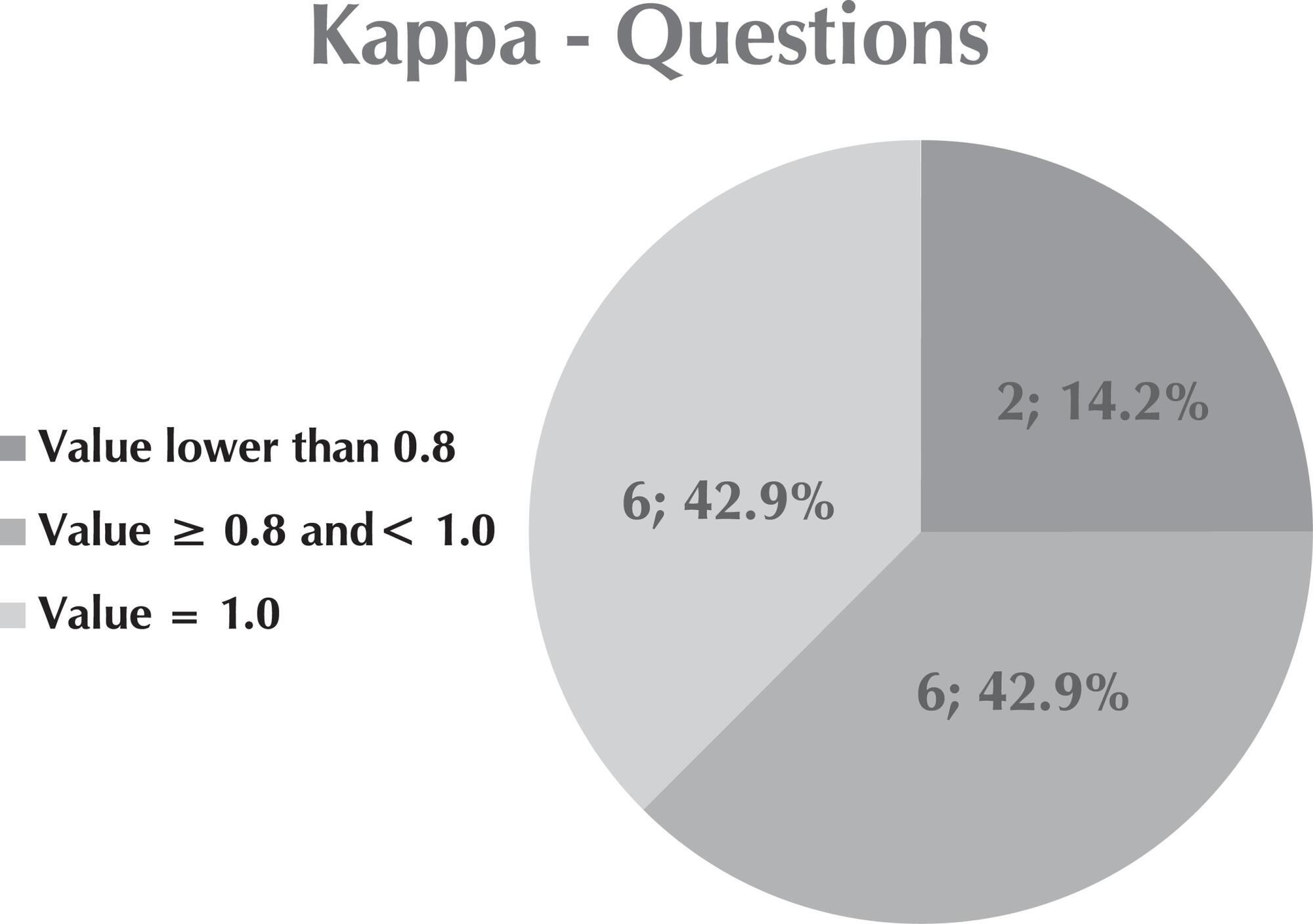
-
PESQUISA01/01/2017
The experience of rural families in the face of cancer
Revista Brasileira de Enfermagem. 2017;70(3):550-557
Resumen
PESQUISAThe experience of rural families in the face of cancer
Revista Brasileira de Enfermagem. 2017;70(3):550-557
DOI 10.1590/0034-7167-2016-0367
Visualizações0Ver maisABSTRACT
Objective:
To understand the meanings of cancer within the experience of rural families and how such meanings influence family dynamics.
Method:
Qualitative study guided by Symbolic Interactionism as a theoretical framework and Grounded Theory as a methodological framework. Six rural families (18 participants) undergoing the experience of having a relative with cancer participated in the interview.
Results:
Constant comparative analysis of data allowed the elaboration of an explanatory substantive theory, defined by the main category Caregiving to support the family world, which represents the family’s symbolic actions and strategies to reconcile care for the patient and care for family life.
Final considerations:
Throughout the experience, rural families seek to preserve the interconnected symbolic elements that provide support for the family world: family unit, land, work and care.

-
PESQUISA01/01/2017
Contributions of Public Health to nursing practice
Revista Brasileira de Enfermagem. 2017;70(3):543-549
Resumen
PESQUISAContributions of Public Health to nursing practice
Revista Brasileira de Enfermagem. 2017;70(3):543-549
DOI 10.1590/0034-7167-2016-0401
Visualizações0Ver maisABSTRACT
Objective:
Analyze the perceptions of undergraduate nursing students about the contributions of public health to nursing practice in the Unified Health System.
Method:
Qualitative Descriptive Study. Data collection was carried out through semi-directed interviews with 15 students. The language material was analyzed according to content and thematic analysis.
Results:
Thematic categories were established, namely: «Perceptions about Public Health» and «Contribution of Public Health to nursing practice in the Unified Health System».
Final considerations:
Perceptions about Public Health are diversified, but converge to the recognition of this field as the basis for training nurses qualified to work in the SUS with technical competence, autonomy and focusing on the integrality in health care.
-
PESQUISA01/01/2017
Cancellation of elective surgeries in a Brazilian public hospital: reasons and estimated reduction
Revista Brasileira de Enfermagem. 2017;70(3):535-542
Resumen
PESQUISACancellation of elective surgeries in a Brazilian public hospital: reasons and estimated reduction
Revista Brasileira de Enfermagem. 2017;70(3):535-542
DOI 10.1590/0034-7167-2016-0084
Visualizações0Ver maisABSTRACT
Objective:
To characterize cancellations of elective surgeries according to clinical and non-clinical reasons, as well as to verify seasonal influence and determine the estimated reduction of the index.
Method:
Quantitative, descriptive and retrospective study with secondary data extracted from the Public Hospital of the State of São Paulo database.
Results:
Out of the 8,443 (100%) elective surgeries scheduled, 7,870 (93.21%) were performed and 573 (6.79%) were canceled. Out of these 573 (100%) people, 48.33% were canceled for clinical reasons and 46.40% were for non-clinical reasons. Among the non-clinical reasons for surgery cancellations, those related to medical reasons stood out: at the request of the surgeon/change of approach (17.93%), followed by non-hospitalized patient (8.96%). There was no indication of seasonality regarding the reasons for cancellation in the assessed period.
Conclusion:
Although the rate of elective surgeries cancellations is lower than that of other hospitals with similar characteristics, it is still possible to reduce it from 6.79% to 1.36%, considering that 80% of the reasons for cancellation are avoidable.

-
PESQUISA01/01/2017
Guide of attributes of the nurse’s political competence: a methodological study
Revista Brasileira de Enfermagem. 2017;70(3):526-534
Resumen
PESQUISAGuide of attributes of the nurse’s political competence: a methodological study
Revista Brasileira de Enfermagem. 2017;70(3):526-534
DOI 10.1590/0034-7167-2016-0483
Visualizações0Ver maisABSTRACT
Objective:
To build and validate a guide of attributes of the nurse’s political competence.
Method:
Methodological research. This study comprised the construction of the instrument through literature review; experts validation of pre-established attributes for composing the guide; and clinical validation in the nurses work environment/reality. The data collection took place in the months from August to October 2014, and the analysis was based on the content analysis of Bardin and use of Epi info 3.5. All ethical precepts have been complied with.
Results:
From 29 attributes found in the literature, 25 have been validated by experts. Clinical/practical validation involved the participation of 43 nurses, who observed that the attributes are not articulated with the professional practices developed by them.
Conclusion:
The attributes of the nurse’s political competence were identified with support of literature. It is concluded that the professionals still have limited and fragmented perception of political competence, expressing difficulty/limitation.
-
14/04/2021
Child behavior during the social distancing in the COVID-19 pandemic
Revista Brasileira de Enfermagem. 2021;74:e20200762
Resumen
Child behavior during the social distancing in the COVID-19 pandemic
Revista Brasileira de Enfermagem. 2021;74:e20200762
DOI 10.1590/0034-7167-2020-0762
Visualizações0Ver maisABSTRACT
Objective:
To describe the daily activities performed by children from 6 to 12 years of age incomplete and analyze children’s behavior during social distancing in the face of the COVID-19 pandemic.
Methods:
Cross-sectional study with children in a learning stage living in Brazil. The data were collected via online form. Fisher’s exact test was applied to analyze the association of categorical variables with child behavior; when significant, it was used the odds ratio. It was considered results considered statistically significant those presenting values of p < 0.05.
Results:
Data from 530 children were analyzed: 50.3% female, 71.3% from the Southeast Region, 73% in fulltime social distancing, 52% presented anxiety, which was significantly associated with changes in sleep and appetite.
Conclusion:
The results indicate the need for parents/caretakers to stimulate moments for the child to express themselves, not minimizing their feelings and providing emotional support to mitigate the negative impact of these feelings on the child’s mental and physical health.
-
05/12/2019
Hospital care and urinary incontinence in the elderly
Revista Brasileira de Enfermagem. 2019;72:284-293
Resumen
Hospital care and urinary incontinence in the elderly
Revista Brasileira de Enfermagem. 2019;72:284-293
DOI 10.1590/0034-7167-2018-0273
Visualizações0Ver maisABSTRACT
Objective:
to identify factors inherent in hospital care that favor urinary incontinence in the elderly.
Method:
an integrative review with Scopus, CINAHL and Pubmed searches. Includes original articles, no language restriction, published between 2008 and 2018. Rated level of recommendation and level of evidence were assessed using the Oxford Center for Evidence-Based Medicine classification. Exploited content through thematic analysis in light of the Donabedian model.
Results:
13 articles constituted the sample. There were factors such as the unjustified and indiscriminate use of devices such as the geriatric diaper; hospital structure adversely affecting the needs of the elderly; and deficit in screening, risk identification and underreporting of the problem favor urinary incontinence in the hospitalized elderly.
Conclusion:
modifiable factors related to hospital structures and care processes favor both the onset and worsening of urinary incontinence in the elderly.
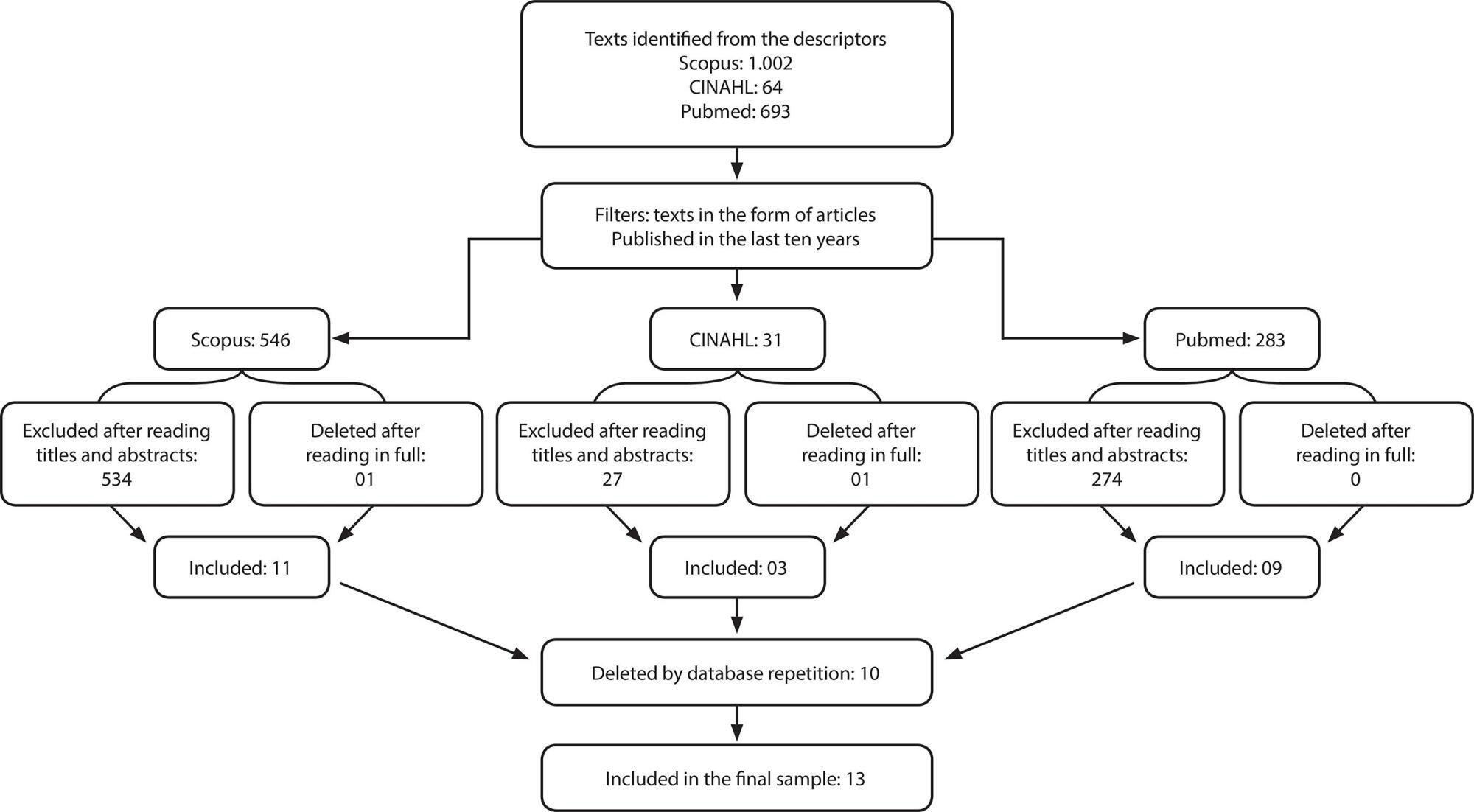
-
ARTÍCULO ORIGINAL21/10/2019
Hipermídia educativa sobre assistência de enfermagem ao parto: construção e validação de conteúdo e aparência
Revista Brasileira de Enfermagem. 2019;72(6):1471-1478
Resumen
ARTÍCULO ORIGINALHipermídia educativa sobre assistência de enfermagem ao parto: construção e validação de conteúdo e aparência
Revista Brasileira de Enfermagem. 2019;72(6):1471-1478
DOI 10.1590/0034-7167/2018-0163
Visualizações1Ver maisRESUMO
Objetivo:
construir uma hipermídia educativa sobre a assistência de enfermagem ao parto de risco habitual e realizar a validação de conteúdo e de aparência.
Método:
pesquisa metodológica, realizada seguindo as seguintes etapas: levantamento do conteúdo e planejamento dos módulos; produção das mídias e organização das unidades tutoriais; organização do espaço do aluno, tutor e de comunicação entre eles; elaboração da hipermídia; disponibilização da hipermídia; avaliação por especialistas em Enfermagem e Informática; e implementação das sugestões propostas.
Resultados:
a hipermídia educativa mostrou-se como um material validado, visto que apresentou um ótimo índice de validade de conteúdo global de 0,97 e significância estatística no teste binomial para o conteúdo e aparência.
Conclusão:
acredita-se que o uso deste material com alunos da graduação em Enfermagem contribuirá com a qualidade da assistência obstétrica, tendo em vista que se constitui em uma tecnologia ilustrada capaz de favorecer o ensino-aprendizagem sobre parto normal humanizado.
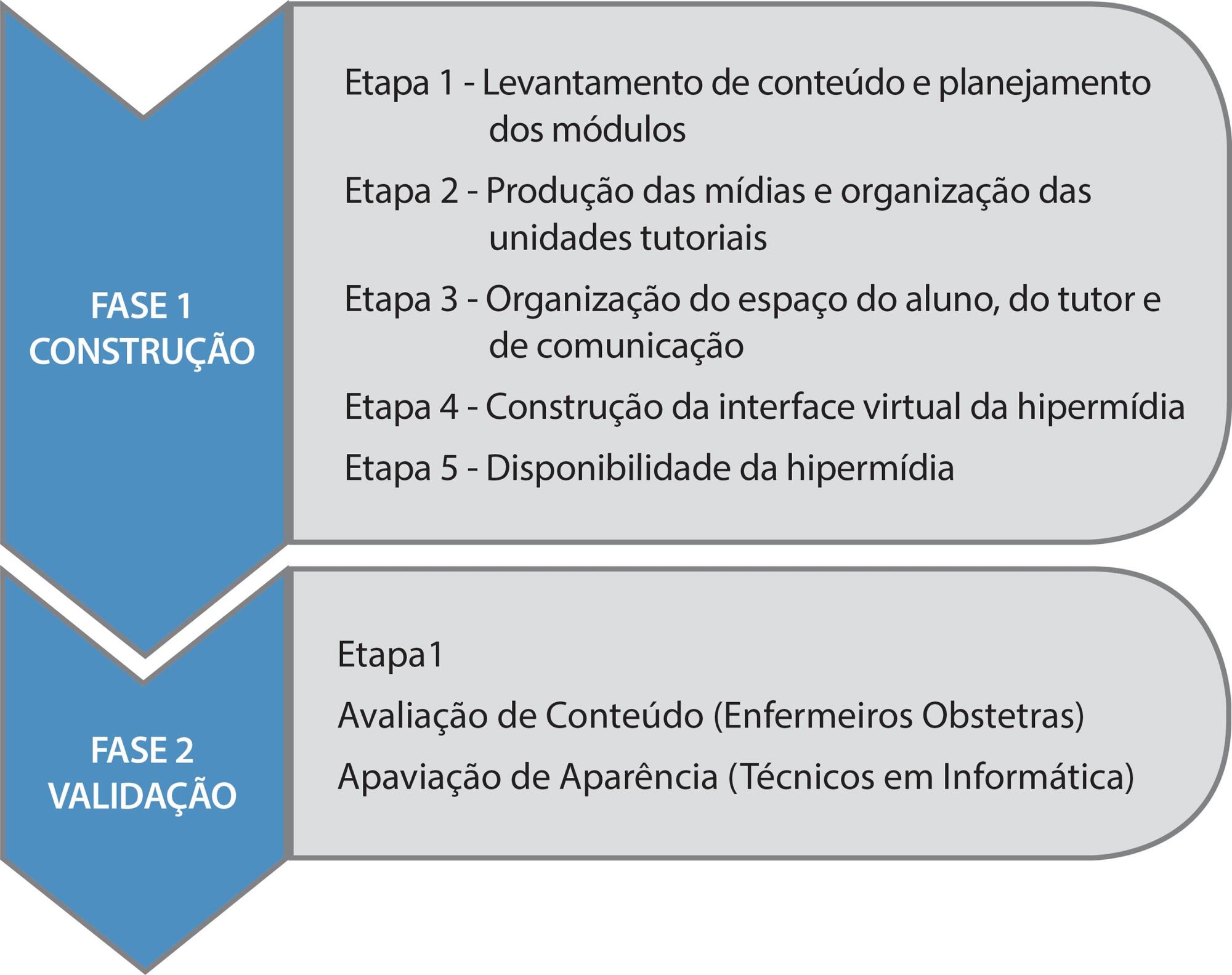
-
ARTÍCULO ORIGINAL30/03/2020
Boas Práticas de segurança nos cuidados de enfermagem em Terapia Intensiva Neonatal
Revista Brasileira de Enfermagem. 2020;73(2):e20180482
Resumen
ARTÍCULO ORIGINALBoas Práticas de segurança nos cuidados de enfermagem em Terapia Intensiva Neonatal
Revista Brasileira de Enfermagem. 2020;73(2):e20180482
DOI 10.1590/0034-7167-2018-0482
Visualizações0RESUMO
Objetivos:
identificar a percepção dos profissionais de enfermagem sobre o erro humano nos cuidados de enfermagem na Unidade de Terapia Intensiva Neonatal; analisar as estratégias de Boas Práticas propostas por esses profissionais para a segurança do paciente nos cuidados de enfermagem.
Métodos:
estudo quanti-qualitativo, descritivo. Cenário: Unidade de Terapia Intensiva Neonatal. Participantes: 22 profissionais de enfermagem. Coleta dos dados realizada por meio de entrevistas e submetidos a análise temática.
Resultados:
erro humano nos cuidados de enfermagem, identificando-se perdas de cateteres e erros no processo de medicação; causas para o erro nos cuidados de enfermagem, destacando-se a sobrecarga de trabalho; Boas Práticas para a segurança do paciente nos cuidados de enfermagem, como capacitação profissional e melhorias das condições de trabalho.
Conclusões:
demonstra-se a importância de investir em estratégias de Boas Práticas para a Segurança do Paciente, buscando-se sedimentar a cultura de segurança organizacional e estimular um ambiente propício ao gerenciamento do erro.
Palavras-chave: EnfermagemErros MédicosGestão de SegurançaSegurança do PacienteUnidades de Terapia Intensiva NeonatalVer mais -
ARTÍCULO DE REVISIÓN29/09/2022
Nursing students’ learning from involvement in research projects: an integrative literature review
Revista Brasileira de Enfermagem. 2022;75(1):e20210053
Resumen
ARTÍCULO DE REVISIÓNNursing students’ learning from involvement in research projects: an integrative literature review
Revista Brasileira de Enfermagem. 2022;75(1):e20210053
DOI 10.1590/0034-7167-2021-0053
Visualizações0Ver maisABSTRACT
Objective:
To identify the learning outcomes and skills obtained of undergraduate nursing students involved in research projects.
Methods:
This was an integrative literature review, based on a research protocol in the CINAHL Complete databases; Cochrane Central Register of Controlled Trials; Cochrane Database of Systematic Reviews; Cochrane Methodology Register; MedicLatina; MEDLINE, Scopus and JBI, including primary and secondary studies, published between 2015 and 2020.
Results:
A total of five heterogeneous articles were included, which were categorized using Kirkpatrick’s (adapted) model. Seventeen learning outcomes acquired through participation in research projects were identified, from the learning of new knowledge and skills to the development of new attitudes and behaviors.
Final considerations:
The involvement of nursing students in research projects is important to their professional development. Future investment in research on this topic can help cement the potential of this type of student involvement.
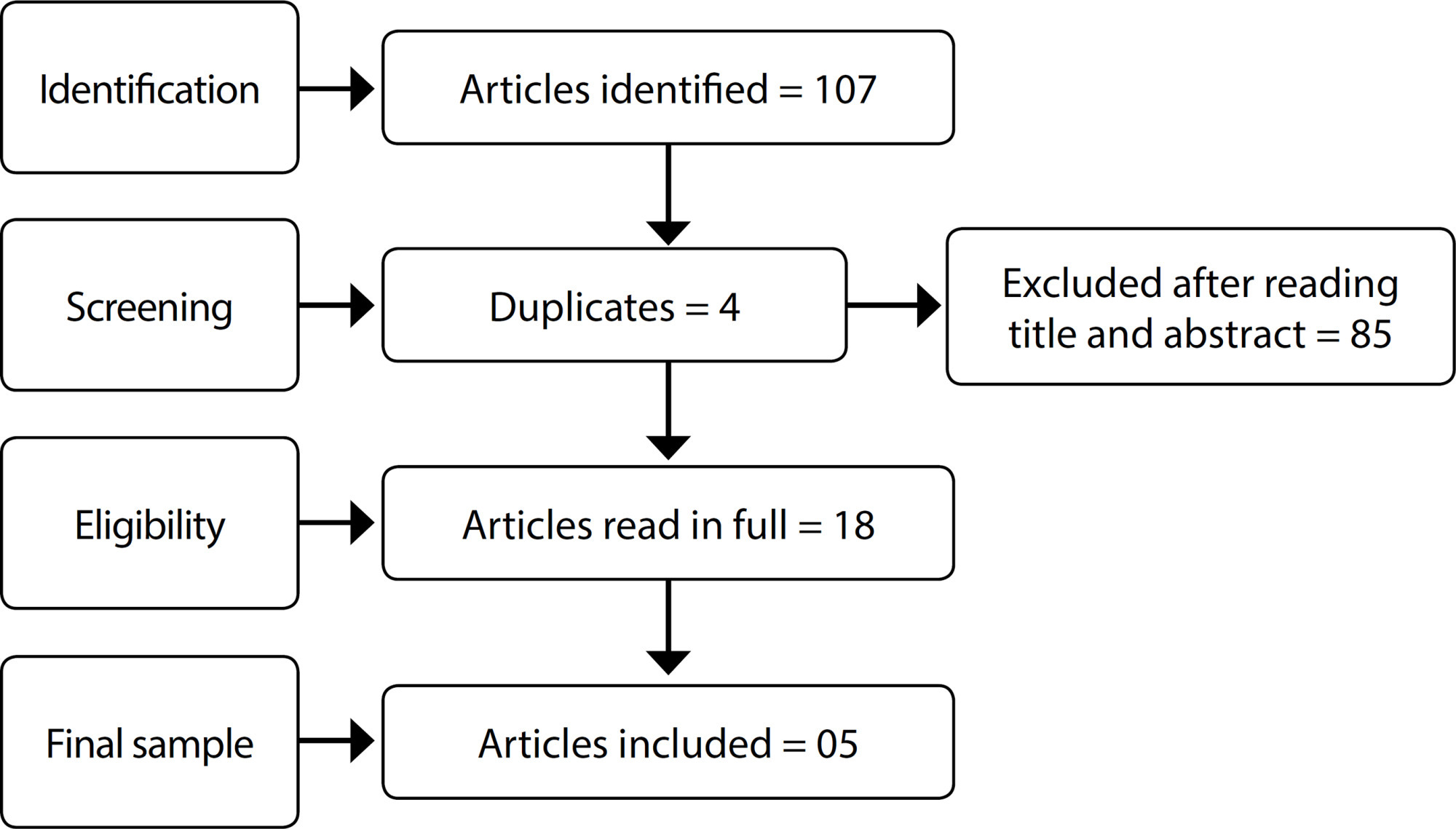
-
ARTÍCULO ORIGINAL05/12/2019
Qualidade de vida relacionada à saúde em pacientes com insuficiência cardíaca
Revista Brasileira de Enfermagem. 2019;72:140-146
Resumen
ARTÍCULO ORIGINALQualidade de vida relacionada à saúde em pacientes com insuficiência cardíaca
Revista Brasileira de Enfermagem. 2019;72:140-146
DOI 10.1590/0034-7167-2018-0368
Visualizações1RESUMO
Objetivo:
Avaliar a qualidade de vida relacionada à saúde dos pacientes com insuficiência cardíaca e relacionar aos dados sociodemográficos e clínicos.
Método:
Trata-se de estudo observacional, de corte transversal, com abordagem quantitativa realizado em ambulatório de insuficiência cardíaca no estado de Pernambuco.
Resultados:
Na amostra (n=101) houve predominância de homens, maiores de 60 anos, casados, profissionalmente inativos. A qualidade de vida relacionada à saúde, a partir do questionário Minnesota Living With Heart Failure Questionnaire foi considerada moderada (34,3±21,6), apresentando relação significativa com idade (p=0,004), classe funcional (p<0,001) e em pacientes com cardiopatia chagásica (p=0,02).
Conclusão:
A qualidade de vida no grupo IC de etiologia chagásica esteve mais comprometida, especialmente na dimensão emocional. Sugere-se a realização de estudos abordando as hipóteses de que maior tempo de acompanhamento ambulatorial melhora a qualidade de vida e que ter doença de Chagas interfere negativamente na qualidade de vida de pacientes com insuficiência cardíaca.
Palavras-chave: Assistência AmbulatorialDoença de ChagasEnfermagemInsuficiência CardíacaQualidade de VidaVer mais -
ARTÍCULO DE REVISIÓN21/12/2020
Aplicação da metodologia Lean Seis Sigma nos cenários de assistência à saúde: revisão integrativa
Revista Brasileira de Enfermagem. 2020;73:e20190861
Resumen
ARTÍCULO DE REVISIÓNAplicação da metodologia Lean Seis Sigma nos cenários de assistência à saúde: revisão integrativa
Revista Brasileira de Enfermagem. 2020;73:e20190861
DOI 10.1590/0034-7167-2019-0861
Visualizações0RESUMO
Objetivo:
analisar a produção científica sobre os resultados da metodologia Lean Six Sigma nas instituições de assistência à saúde.
Métodos:
revisão integrativa da literatura, com a seguinte pergunta: quais são os resultados nas instituições de saúde com a utilização da metodologia Lean Six Sigma e Six Sigma? A busca foi realizada nas bases de dados MEDLINE, LILACS, BDENF, CINAHL, Web of Science e Scopus, sem recorte temporal.
Resultados:
foram incluídos 34 artigos, publicados entre 2005 e 2019, sendo 52,9% provenientes dos Estados Unidos da América. As melhorias mais comumente encontradas foram em instituições hospitalares e na perspectiva dos clientes e processos internos.
Conclusão:
a utilização da metodologia Lean Six Sigma se demonstrou eficaz nos diversos cenários de assistência à saúde, se destacando uma lacuna em sua aplicação quanto ao engajamento e capacitação de pessoas.
Palavras-chave: Administração em SaúdeAssistência à SaúdeControle de QualidadeGestão da Qualidade TotalMelhoria de QualidadeVer mais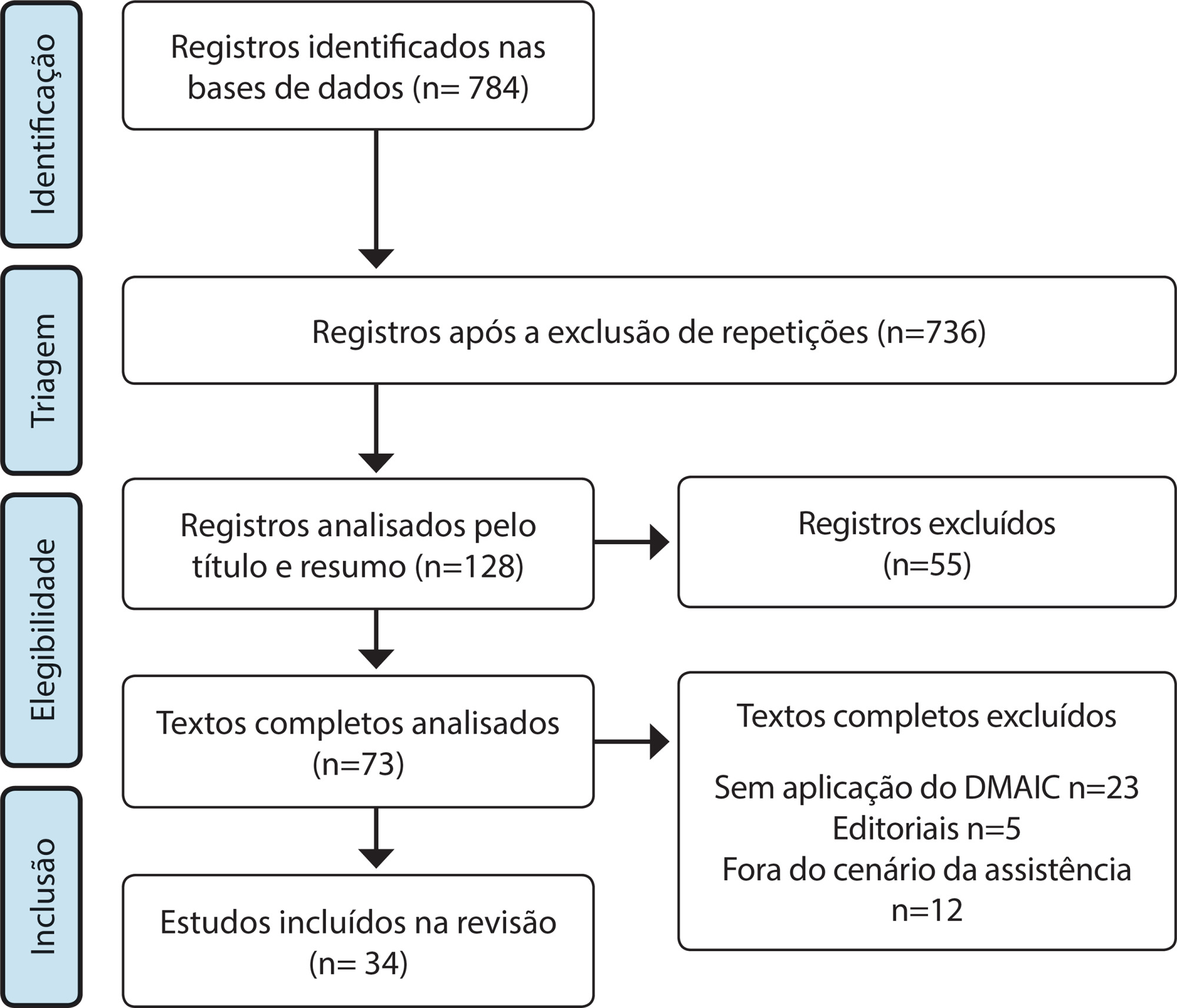
-
ARTÍCULO ORIGINAL17/02/2020
Análise dos registros de técnicos de enfermagem e enfermeiros em prontuários
Revista Brasileira de Enfermagem. 2020;73(2):e20180542
Resumen
ARTÍCULO ORIGINALAnálise dos registros de técnicos de enfermagem e enfermeiros em prontuários
Revista Brasileira de Enfermagem. 2020;73(2):e20180542
DOI 10.1590/0034-7167-2018-0542
Visualizações0RESUMO
Objetivos:
analisar as principais não conformidades dos registros de enfermagem de um hospital público do Nordeste na cidade de Natal.
Métodos:
estudo descritivo, transversal, abordagem quantitativa. Realizado em enfermarias médicas e cirúrgicas. Amostra composta de 120 prontuários de pacientes internados entre outubro e dezembro de 2016. Os dados obtidos foram tabulados e analisados por estatística simples em frequência absoluta e relativa com o software Microsoft Excel 2013. Para avaliar as não conformidades dos registros, usou-se o Diagrama de Pareto.
Resultados:
como principais problemas nos registros de enfermagem, destacou-se a ausência da categoria profissional e número do conselho, responsáveis por 41,8% das não conformidades nos registros de técnicos de enfermagem, enquanto nas anotações dos enfermeiros foram a ausência de hora e as letras ilegíveis, com 61,2%.
Conclusões:
o estudo evidenciou que os profissionais de enfermagem realizam seus registros de forma incompleta e que muitas vezes não documentam o cuidado prestado.
Palavras-chave: ComunicaçãoEnfermagemPesquisa sobre Serviços de SaúdeRegistros de EnfermagemSegurança do PacienteVer mais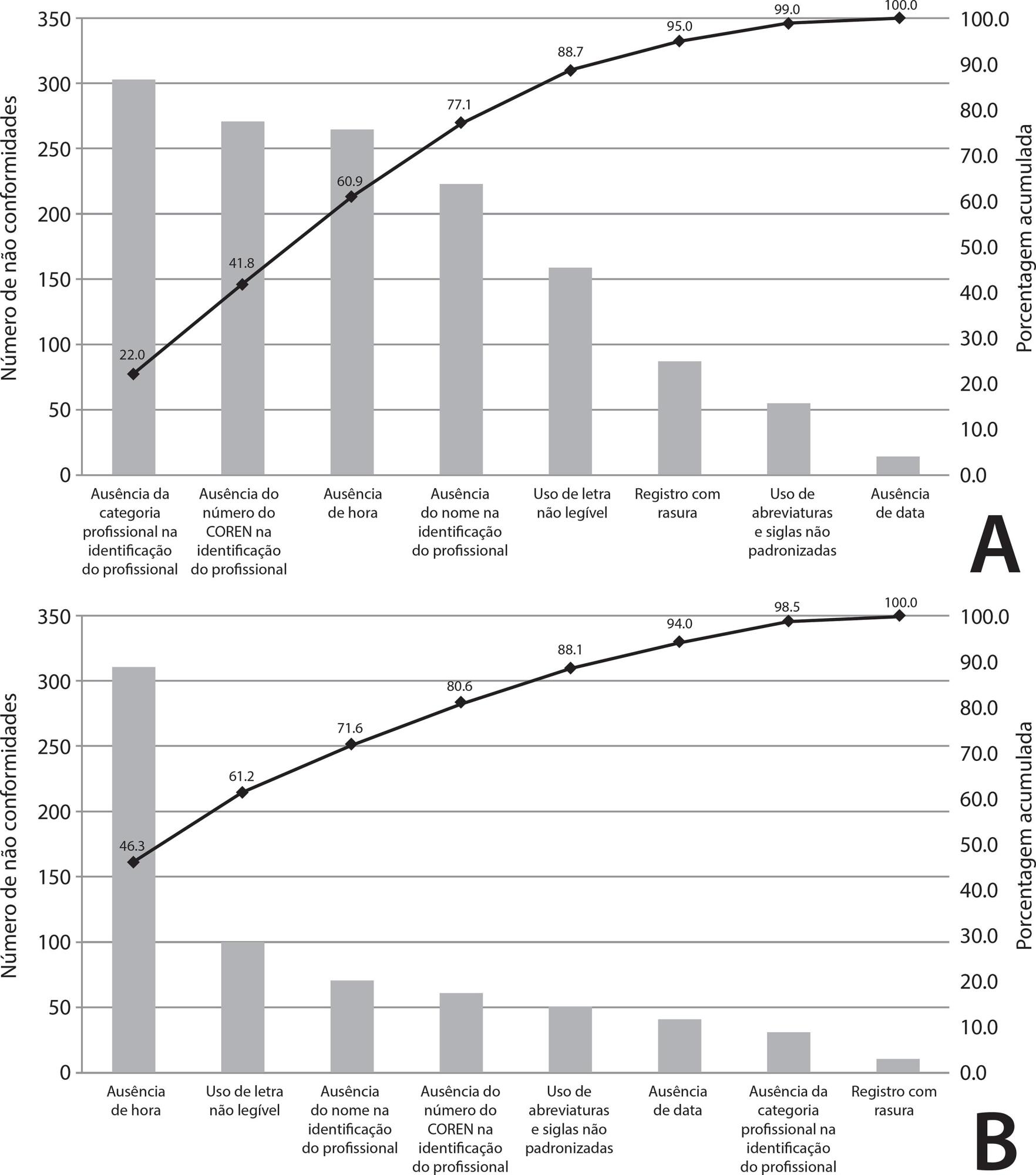
Búsqueda
Buscar en:
Nuvem de Tags
Adolescente (85) Atenção Primária à Saúde (239) COVID-19 (91) Criança (91) Cuidados de Enfermagem (269) Educação em Enfermagem (151) Educação em Saúde (139) Enfermagem (930) Enfermagem Pediátrica (86) Estudantes de Enfermagem (77) Estudos de Validação (131) Família (87) Idoso (208) Promoção da Saúde (99) Qualidade de Vida (104) Saúde do Trabalhador (86) Saúde Mental (145) Saúde Pública (82) Segurança do Paciente (150) Tecnologia Educacional (100)



